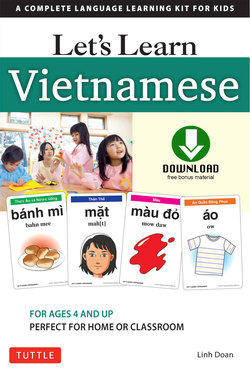Читать книгу Let's Learn Vietnamese Ebook - Linh Doan - Страница 6
ОглавлениеHow to Use the
Let’s Learn Vietnamese Language
Learning Kit
Introduction
Welcome to the world of Tuttle language learning with flash cards. We hope that the language presented in this set of cards will help you begin speaking and reading Vietnamese with your child.
Whether you are a native speaker or just beginning to learn Vietnamese with your child, you can teach the language to your child in a natural, simple way by integrating the language into your daily speech. All parents teach their child a first language simply by talking with them on a day-to-day basis and commenting on all the activities that are happening. For instance, when choosing clothes for your child to wear, you say, “Which shirt should we wear today?” Or how you address another individual, you say, “Hello, Linh.” In the same way, you can teach your child a new language. The best way to learn a foreign language is by jumping in and speaking it as much as possible, and these flash cards will help you begin to do that.
Furthermore, this set of flash cards is useful even for children as young as 18 months. Studies on foreign language acquisition show that there is a window of opportunity from birth to about age 7 that is the ideal time for a child to learn a foreign language. Younger learners absorb the sound, intonation, and structure of a second language intuitively, just as they do their native language, and they can reproduce the second language without a foreign accent. The younger a child is, the better his or her ability to absorb and mimic foreign language, so start early and have fun!
How and Why These Words Work
These are some of the most commonly used words and phrases in daily speech, and are easy to incorporate into your family’s daily routine: for example, rửa tay “wash hands” and ăn cơm “Eat (rice)”. If you begin to say these simple words and commands as part of your daily conversation, children will easily pick them up.
In contrast to set of flash cards that teach only objects, Let’s Learn Vietnamese presents a range of grammatical functions (adjectives, nouns, verbs, pronouns, etc.) so you can begin to combine the words to create your own simple sentences. The words and sample sentences here represent a core vocabulary that will allow you to create a surprising number of sentences.
The words represent a range of sounds in Vietnamese. Some songs are included to make the language learning process fun and easy to remember the vocabularies.
Some Basics About Vietnamese
This set of flash cards helps you learn both the Hanoi (northern) and Saigon (southern) pronunciations. The Hanoi dialect, otherwise called standard Vietnamese, is the version taught in most language programs in Vietnam and abroad, and it is the main usage here. However, as both are common and heard abroad and in Vietnam, you’ll want to understand the differences. To help you with this, we also included key Saigon pronunciation in [brackets] for easy accessibility.
For example, in the North, the letter d is pronounced [z], but in the South it is pronounced [y]. Fortunately, though, most Vietnamese consonants are pronounced the way we’re used to saying them.
Vietnamese is written using the Roman alphabet with a few modifications, such as tone and vowel markers. French missionaries changed the written language from Chinese characters in the 17th century, but their system did not become widespread until the 20th century. Some of the letters or letter combinations they chose to represent the sounds might seem peculiar choices to the native English speaker. Still, Roman letters make Vietnamese much easier to read and write than most other Asian languages.
Pronunciation
CONSONANTS
B like Boy
C like Gas (There is a slight clicking sound made from the back of the throat when you make this sound.)
CH like Chase in the North and Jeans in the South
D like Zipper in the North and Yes in the South
Đ/đ like Dove. Notice the “-” going through both the capital D and small d. This differentiates the “D” sound from the “Z” or “Y” sound.
G like the Gas in English except that this sound is unaspirated, which means that air does not come out of your mouth when you say it.
GH like Golf with the slight aspiration, which means a puff of air
H like House
K like Gas with a slight click at the back of the throat, similar to “C” to you and me.
KH like Kiss with aspiration
L like Love
M like Man
N like No. At the end of the words, particularly in the South, the final N often takes on the sound of “NG” for example, ăn (to eat) will sound like ahn in the North and ahng in the South. We have written this word as ahn[g] to signify that the [g] is only used in the South.
NGH like NG above but with a slight aspiration and a bit of a Y sound at the end: NGY. Try saying siNGY
NH like NY, as in the NIO in oNIO n
P like Peace (used only at the end of words)
PH like PHone
Q/QU like GW or KWanza in the North but often shortened to “W” in the South like Wow
R like Run, particularly in the South. In the North, you will often hear ZR. We have used R throughout; however, to simplify things.
S like SHave, although it is often pronounced “Save,” particularly in the South. We have used SH throughout most of the cards.
